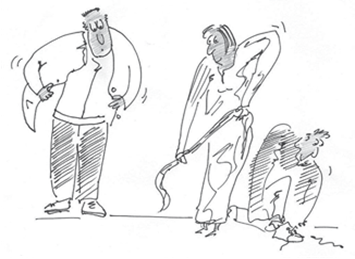Empowered World View
Theme IV. Relationships
We will also begin this by doing a funny activity for 5 minutes-Longest Line
 First, we will divide you into equal teams of same number of women and men
First, we will divide you into equal teams of same number of women and men
“Each team now has five minutes to create the longest line possible using whatever they have between them.
Create a Plan
When I say ‘start’, discuss and create a plan that will enable your team to create the longest line possible. Do your best to work out the fastest way to ensure that your team is the first to create the longest line!
You will note that the activity demonstrates how we can work together to mobilise resources for our families and communities. We will be referring to lessons learned during this activity at a later stage during our workshop.
Debrief Session
How did the group that managed to make a longer line manage?
-Team work
-Plan
-Creativity
Was the line the furthest you could go? If not, what stopped you?
-Satisfaction that we have already won
-Undermining of seemingly immaterial resources eg. shoe laces
-Limited contributions from members due various reasons like I have contributed enough, I can’t
give this out because its precious
Examine the scenarios in your life or community where you did not go further due to the reasons above
Did the group that made a shorter line fail to make a long line because of the above reason or more?
Great facilitation and team work is required to use locally available resources including people to acquire great future
Read John 4:1-42-The woman at the well
|
Back ground to the scripture The Origins of Separation between Israelites and Samaritans The nation of Israel was divided into two nations in the days of Rehoboam (1 Kings 12). Israel was composed of the ten tribes to the north, and Judah was made up of Judah and Benjamin. The hostility between the Jews (inhabitants of Judah, the southern kingdom) and Israelites began immediately after the division between the two kingdoms. Samaria was the capital city of the northern kingdom. Immediately after the division, the inhabitants of the northern kingdom did not travel to Jerusalem to offer sacrifice and worship. Instead, they set up idols in Dan and Bethel. Later, they began to intermarry with the Assyrians. This is why the Jews hated the Samaritans and called them “dogs,” or “half-breeds.” Jewish attitude to women Historically and traditionally, Jewish men did not speak in public with women, even their own wives. For a rabbi this would have been an even greater restriction. Women were not publicly taught the Law. A woman’s place in that society was submissive, as it still is in many parts of the world today. |
|
|

 Jesus Response
Jesus Response Jesus built a relationship with the woman at the well through his non-judgmental attitude and his willingness to cross several boundaries: ethnic, cultural, religious, gender and moral boundaries.
Jesus built a relationship with the woman at the well through his non-judgmental attitude and his willingness to cross several boundaries: ethnic, cultural, religious, gender and moral boundaries.